Borjigin
A Borjigin (Mongolian: Боржигин, romanized: Borjigin; ᠪᠣᠷᠵᠢᠭᠢᠨ;[2] Russian: Борджигин, romanized: Bordžigin; simplified Chinese: 孛儿只斤; traditional Chinese: 孛兒只斤; pinyin: Bó'érjìjǐn; English plural: Borjigins or Borjigid [Middle Mongolian plural], translit. Borǰigit;[3][lower-alpha 1] [Manchu plural?]: ![]()
| Borjigin ᠪᠣᠷᠵᠢᠭᠢᠨ Боржигин | |
|---|---|
| Country | Mongol Empire, Northern Yuan dynasty, Mongolia, China (Inner Mongolia and Xinjiang) |
| Place of origin | Khamag Mongol |
| Founded | ca. 900 AD |
| Founder | Bodonchar Munkhag |
| Final ruler | Şahin Giray[1] |
| Titles | Khagan, Khan, Mirza |
| Religion | Tengrism Buddhism (Yuan Dynasty) (later) Islam(Golden horde, Chagatai Khanate and Ilkhanate) (later) Christianity (later) |
| Estate(s) | Mongolia, Russia, Central Asia, Iran and China |
| Deposition | 1783 |
| Cadet branches | Before Genghis Khan: Khiyan, Tayichigud, Jurkhin After Genghis Khan: Jochids (Girays, Shaybanids), Yuan, House of Hulagu, House of Chagatai |

Origin
The patrilineage began with Blue-grey Wolf (Börte Chino) and Fallow Doe (Gua Maral). According to The Secret History of the Mongols, their 11th generation descendant Dobu Mergen's widow Alan Gua the Fair was impregnated by a ray of light.[9] Her youngest son became the ancestor of the later Borjigid.[10] He was Bodonchar Munkhag, who along with his brothers sired the entire Mongol nation.[11] According to Rashid-al-Din Hamadani, many of the older Mongolian clans were founded by members of the Borjigin — Barlas, Urud, Manghud, Taichiut, Chonos, Kiyat, etc. The first Khan of the Mongol was Bodonchar Munkhag's great-great-grandson Khaidu Khan. Khaidu's grandsons Khabul Khan and Ambaghai Khan (founder of the Taichiut clan) succeeded him. Thereafter, Khabul's sons, Hotula Khan and Yesugei, and Khabuls grandson Temujin (Genghis Khan, son of Yesugei) ruled the Khamag Mongol. By the unification of the Mongols in 1206, virtually all of Temujin's uncles and first cousins had died, and from then on only the descendants of Yesugei Baghatur, his brother Daritai, and nephew Onggur formed the Borjigid.
Name
According to Paul Pelliot and Louis Hambis, Rashid al-Din Hamadani once explained that "borčïqïn" designated in the Turkic languages a man with dark-blue eyes (اشهل, ašhal), and did so again without mentioning the said language, adding that Yesugei's children and the majority of their own children had had such eyes per coincidence, also recalling that the genie which had impregnated Alan Gua after her husband's death had had dark-blue eyes ("ašhal čašm").[5] Abu al-Ghazi Bahadur later paraphrased Hamadani by relating that Yesugei's eyes were dark-blue ("شهلا šahlā"), that the Mongols ("Moɣol") called such eyes "borǰïɣïn" (بورجغن[12]), that his sons and most of their descendants had dark-blue eyes ("ašhal"), and that one recognized thus in Yesugei's lineage the characteristic sign of the genie which had visited Alan Gua and had "borǰïɣïn" eyes, adding that the Arabs called "ašhal" a man whose iris ("bübäčik") was black, cornea white ("aq"), and whose limbal ring was red.[3]
Mongol Empire
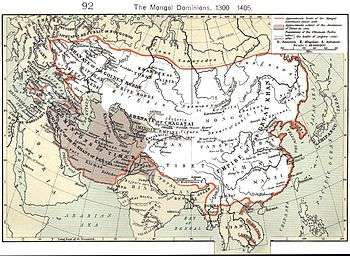
The Borjigin family ruled over the Mongol Empire from the 13th to 14th century. The rise of Genghis (Chingis) narrowed the scope of the Borjigid-Kiyad clans sharply.[13] This separation was emphasized by the intermarriage of Genghis's descendants with the Barlas, Baarin, Manghud and other branches of the original Borjigid. In the western regions of the Empire, the Jurkin and perhaps other lineages near to Genghis's lineage used the clan name Kiyad but did not share in the privileges of the Genghisids. The Borjigit clan had once dominated large lands stretching from Java to Iran and from Indo-China to Novgorod. In 1335, with the disintegration of the Ilkhanate in Iran, the first of numerous non-Borjigid-Kiyad dynasties appeared. Established by marriage partners of Genghisids, these included the Suldus Chupanids, Jalayirids in the Middle East, the Barulas dynasties in Chagatai Khanate and India, the Manghud and Onggirat dynasties in the Golden Horde and Central Asia, and the Oirats in western Mongolia.
In 1368, under Toghun Temür, the Yuan dynasty was overthrown by the Ming dynasty in China but members of the family continued to rule over Mongolia homeland into the 17th century, known as the Northern Yuan dynasty. Descendants of Genghis Khan's brothers, Hasar and Belgutei, surrendered to the Ming in the 1380s. By 1470 the Borjigin lines were severely weakened, and Mongolia was almost in chaos.
Post-Mongol Empire
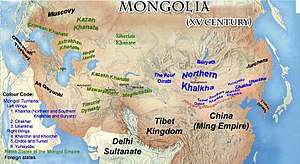
After the breakup of the Golden Horde, the Khiyat continued to rule the Crimea and Kazan until the late 18th century. They were annexed by the Russian Empire and the Chinese. In Mongolia, the Kublaids reigned as Khagan of the Mongols, however, descendants of Ögedei and Ariq Böke usurped the throne briefly.
Under Dayan Khan (1480–1517) a broad Borjigid revival reestablished Borjigid supremacy among the Mongols proper. His descendants proliferated to become a new ruling class. The Borjigin clan was the strongest of the 49 Mongol banners from which the Bontoi clan proper supported and fought for their Khan and for their honor. The eastern Khorchins were under the Hasarids, and the Ongnigud, Abagha Mongols were under the Belguteids and Temüge Odchigenids. A fragment of the Hasarids deported to Western Mongolia became the Khoshuts.
The Qing dynasty respected the Borjigin family and the early emperors married the Hasarid Borjigids of the Khorchin. Even among the pro-Qing Mongols, traces of the alternative tradition survived. Aci Lomi, a banner general, wrote his History of the Borjigid Clan in 1732–35.[14] The 18th century and 19th century Qing nobility was adorned by the descendants of the early Mongol adherents including the Borjigin.[15]
Genghisids
Asian dynasties descended from Genghis Khan included the Yuan dynasty of China, the Ilkhanids of Persia, the Jochids of the Golden Horde, the Shaybanids of Siberia, and the Astrakhanids of Central Asia. As a rule, the Genghisid descent played a crucial role in Tatar politics. For instance, Mamai had to exercise his authority through a succession of puppet khans but could not assume the title of khan himself because he lacked Genghisid lineage.
The word "Chingisid" derives from the name of the Mongol conqueror Genghis (Chingis) Khan (c. 1162–1227 CE). Genghis and his successors created a vast empire stretching from the Sea of Japan to the Black Sea.
- The Chingisid principle,[16] or golden lineage, was the rule of inheritance laid down in the (Yassa), the legal code attributed to Genghis Khan.
- A Chingisid prince was one who could trace direct descent from Genghis Khan in the male line, and who could therefore claim high respect in the Mongol and Turkic world.
- The Chingisid states were the successor states or Khanates after the Mongol empire broke up following the death of the Genghis Khan's sons and their successors.
- The term Chingisid people was used to describe the people of Genghis Khan's armies who came in contact with Europeans. It applied primarily the Golden Horde, led by Batu Khan, a grandson of Genghis. Members of the Horde were predominantly Oghuz — Turkic-speaking people rather than Mongols. (Although the aristocracy was largely Mongol, Mongols were never more than a small minority in the armies and the lands they conquered.) Europeans often (incorrectly) called the people of the Golden Horde "Tartars".
Babur and Humayun, founders of the Mughal Empire in India, asserted their authority as Chinggisids. Because they claimed descent through their maternal lineage, they had never used the clan name Borjigin.
The last ruling monarch of Genghisid ancestry, Maqsud Shah (d. 1930), Khan of Kumul from 1908 to 1930.
Yuan dynasty family tree
Genghis Khan founded the Mongol Empire in 1206. His grandson, Kublai Khan, after defeating his younger brother Ariq Böke, founded the Yuan dynasty in China in 1271. The dynasty was overthrown by the Ming dynasty during the reign of Toghaghan-Temür in 1368, but it survived in Mongolia homeland, known as the Northern Yuan dynasty. Although the kingship was usurped by Esen Taishi of the Oirats in 1453, he was overthrown in the next year. A recovery of the khaganate was achieved by Dayan Khan, but the territory was segmented by his descendants. The last khan Ligden died in 1634 and his son Ejei Khongor submitted himself to Hong Taiji the next year, ending the Northern Yuan regime.[17] However, the Borjigin nobles continued to rule their subjects until the 20th century under the Qing.[18][lower-alpha 2]
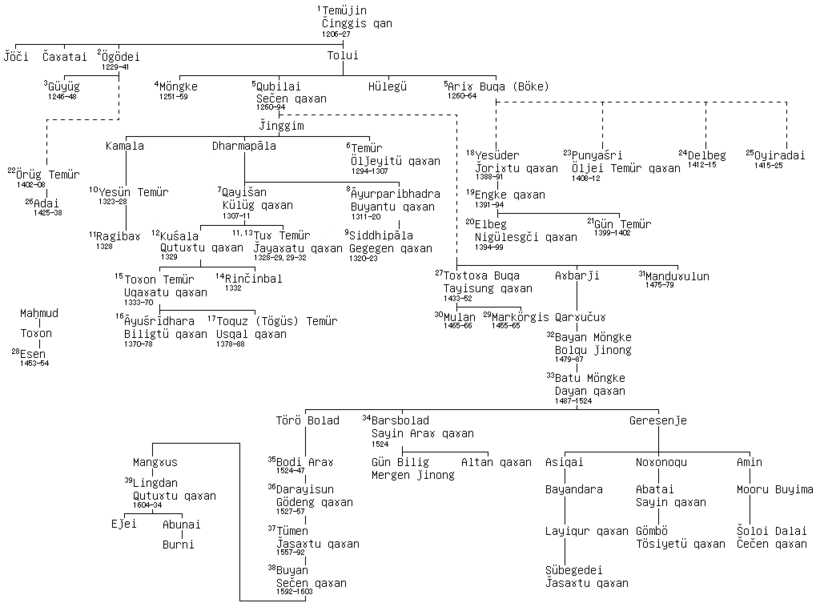
Or in a different version (years of reign over the Northern Yuan dynasty [up to 1388] are given in brackets).
Modern relevance and descent from Genghis Khan
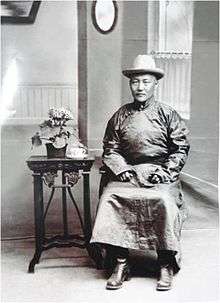
The Borjigin held power over Mongolia for many centuries (even during Qing period) and only lost power when Communists took control in the 20th century. Aristocratic descent was something to be forgotten in the socialist period.[19] Joseph Stalin's associates executed some 30,000 Mongols including Borjigin nobles in a series of campaigns against their culture and religion.[20] Clan association has lost its practical relevance in the 20th century, but is still considered a matter of honour and pride by many Mongolians. In 1920s the communist regime banned the use of clan names. When the ban was lifted again in 1997, and people were told they had to have surnames, most families had lost knowledge about their clan association. Because of that, a disproportionate number of families registered the most prestigious clan name Borjigin, many of them without historic justification.[21][22] The label Borjigin is used as a measure of cultural supremacy.[23]
In Inner Mongolia, the Borjigid or Kiyad name became the basis for many Chinese surnames adopted by ethnic Inner Mongols.[13] The Inner Mongolian Borjigin Taijis took the surname Bao (鲍, from Borjigid) and in Ordos Qi (奇, Qiyat). A genetic research has proposed that as many as 16 million men from populations as far apart as Hazaras in the West and Hezhe people to the east may have Borjigid-Kiyad ancestry,[24] but the professionalism of that study is being criticised. The Qiyat clan name is still found among the Kazakhs, Uzbeks and Karakalpaks.
List of Kiyad-Borjigin dynasties
- Khamag Mongol
- Mongol Empire:
- Golden Horde
- Kazan Khanate
- Shaibanid
- Kazakh Khanate
- Giray Dynasty
- Great Horde
- Astrakhan Khanate
- Chagatai Khanate
- Kara Del
- Yarkent Khanate
- Moghulistan
- Kumul Khanate
- Turfan Khanate
- Yuan dynasty
- Northern Yuan dynasty
- Khanate of Tümed
- Khalkha federation
- Tüsheet Khan
- Dzasagtu-khan
- Sechen-khan
- Altyn Khan
- Northern Yuan dynasty
- Ilkhanate
- Khoshut Khanate
- Golden Horde
- Gurkani (maternal)
- Qing dynasty (from the second Emperor)
Claimed ancestry
Prominent Kiyads or Borjigins
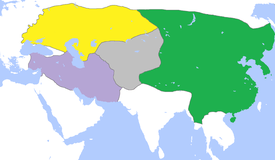
Rulers of the Khamag Mongol (11th century – 1206)
- Khaidu
- Khabul Khan
- Yesugei
Emperors and rulers of the Mongol Empire (1206–1368)
Rulers of the Khanates
Golden Horde
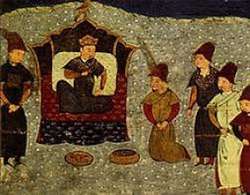
Post-Mongol Empire Golden Horde (1360–1502)
- Urus Khan
- Toqtamish
- Mamai[lower-alpha 3]
- Olug Moxammat
Crimean Khanate (1441–1783)
- Mengli Giray
Kazan Khanate (1438–1552)
- Olug Moxammat
Uzbek Khanate (1428–1471)
Kazakh Khanate (1456–1847)
- Janybek Khan
Ruler of the Tumed
Khalkha
Qing dynasty (1636–1912)
Prince Consort
| Date | Prince Consort | Princess |
|---|---|---|
| 1622 | Babai (巴拜) | Šurhaci's tenth daughter (b. 1603) by secondary consort (Gūwalgiya) |
| 1648 | Hashang (哈尚; d. 1651) | Hong Taiji's ninth daughter (1635–1652) by secondary consort (Jarud Borjigit) |
| 1651 | Bandi (班迪; d. 1700) | Hong Taiji's 12th daughter (1637–1678) by mistress (Sayin Noyan) |
| 1756 | Banzhu'er (班柱兒/班柱儿) | Yunbi's fourth daughter (b. 1738) by secondary consort (Niohuru) |
| Gunqilaxi (袞齊拉喜/袞齐拉喜) | Yuntao's fifth daughter (1740–1797) by mistress (Wanggiya) |
Imperial Consort
| Imperial Consort | Emperor | Sons | Daughters |
|---|---|---|---|
| Consort Yu (1730–1774) | Qianlong Emperor |
Princess Consort
| Princess Consort | Prince | Sons | Daughters |
|---|---|---|---|
| Primary consort | Prince Degelei | 1. Dekexike (1616–1645) | |
| Šose, Prince Chengzeyu | |||
| Yongzhang, Prince Xun | |||
| Prince Yongji |
Abaga Mongols
Prince Consort
| Date | Prince Consort | Princess |
|---|---|---|
| 1647 or 1648 | Garma Sodnam (噶爾瑪索諾木/噶尔马索诺木; d. 1663) | Princess Duanshun (1636–1650), Hong Taiji's 11th daughter by Noble Consort Yijing (Abaga Borjigit Namuzhong) |
Imperial Consort
| Imperial Consort | Emperor | Sons | Daughters |
|---|---|---|---|
| Noble Consort Yijing (Namuzhong; d. 1674) | Hong Taiji | 11. Prince Bomubogor (1642–1656) | 11. Princess Duanshun (1636–1650) |
| Consort Kanghuishu (Batemazao) | |||
| Consort Duanshun (d. 1709) | Shunzhi Emperor |
Abahai (阿巴亥) Mongols
Princess Consort
| Princess Consort | Prince | Sons | Daughters |
|---|---|---|---|
| Primary consort | Duke Yun'e | 5. Hongxuan (1708–1735) |
Alxa (阿拉善) Mongols
Prince Consort
| Date | Prince Consort | Princess |
|---|---|---|
| 1780 | Wangqinbanba'er (旺親班巴爾/旺亲班巴尔; 1755–1804) | Yongqi's first daughter (1762–1780) by mistress (Hu) |
| 1785 | Yongcheng's second daughter (1769–1787) by secondary consort (Wanyan) | |
| 1925 | Darijaya (1906–1968) | Zaitao's second daughter (Yunhui; 1906–1969) by wife (Jiang Wanzhen) |
Aohan Mongols
Prince Consort
| Date | Prince Consort | Princess |
|---|---|---|
| 1627 | Sodnom Dügüreng (索諾木杜棱/索诺木杜棱; d. 1644) | Nurhaci's third daughter (Mangguji; 1590–1636) by primary consort (Fuca Gundei) |
| 1633 | Bandi (班第; d. 1647) | Princess Aohan (1621–1654), Hong Taiji's first daughter by primary consort (Ula Nara) |
| 1731 | Pengsukelashi (彭蘇克拉氏/彭苏克拉氏) | Yunreng's eighth daughter (1714–1760) by secondary consort (Cenggiya) |
| 1733 | Wangzha'er (汪扎爾/汪扎尔) | Yunzhi's tenth daughter (1717–1755) by mistress (Guo) |
| 1734 | Laxi (拉錫/拉锡) | Yunzhi's seventh daughter (1711–1736) by mistress (Chao) |
| 1743 or 1744 | Luobocangxilapu (羅蔔藏錫喇普/罗卜藏锡喇普) | Yunyi's first daughter (1727–1795) by secondary consort (Cui) |
| 1747 | Gengdouzha'er (庚都扎爾/庚都扎尔) | Yunhu's third daughter (1733–1805) by mistress (Yang) |
| 1787 | Deweiduo'erji (德威多爾濟/德威多尔济) | Yongxing's second daughter (1770–1800) by secondary consort (Liugiya) |
Barin Mongols
Prince Consort
| Date | Prince Consort | Princess |
|---|---|---|
| 1648 | Sabdan (色布騰/色布腾; d. 1667) | Princess Shuhui (Atu; 1632–1700), Hong Taiji's fifth daughter by Empress Xiaozhuangwen (Khorchin Borjigit Bumbutai) |
| 1691 | Örgen (烏爾袞/乌尔衮; d. 1721) | Princess Rongxian (1673–1728), the Kangxi Emperor's third daughter by Consort Rong (Magiya) |
| 1719 | Kanbu (侃布) | Yuntang's second daughter (1703–1741) by mistress (Zhao) |
| 1751 | Deleke (德勒克/德勒克; d. 1794) | Princess Hewan (1734–1760), Hongzhou's first daughter by primary consort (Ujaku) |
| 1791 | Gongsaishang'a (公賽尚阿/公赛尚阿) | Yongxuan's first daughter (1769–1820) by secondary consort (Wang Yuying) |
Chahar Mongols
Prince Consort
| Date | Prince Consort | Princess |
|---|---|---|
| 1636 | Ejei (d. 1641) | Princess Wenzhuang (Makata; 1625–1663), Hong Taiji's second daughter by Empress Xiaoduanwen (Khorchin Borjigit Jerjer) |
| 1645 | Abunai (阿布奈; 1635–1675) |
Dinghao (鼎浩) Mongols
Prince Consort
| Date | Prince Consort | Princess |
|---|---|---|
| 1742 | Dunduobuduo'erji (敦多布多爾濟/敦多布多尔济) | Yunxu's fourth daughter (1722–1745) by secondary consort (Gūwalgiya) |
Dun'erluosi (敦爾羅斯) Mongols
Prince Consort
| Date | Prince Consort | Princess |
|---|---|---|
| 1738 | Sumadi (蘇馬第/苏马第) | Yunqi's sixth daughter (1711–1744) by mistress (Zhang) |
Hotsit (浩齊特) Mongols
Imperial Consort
| Imperial Consort | Emperor | Sons | Daughters |
|---|---|---|---|
| Consort Gongjing (d. 1689) | Shunzhi Emperor |
Jarud Mongols
Prince Consort
| Date | Prince Consort | Princess |
|---|---|---|
| 1645 | Lamasi (喇瑪思/喇玛思) | Princess Shuzhe (1633–1648), Hong Taiji's seventh daughter by Empress Xiaozhuangwen (Khorchin Borjigit Bumbutai) |
Imperial Consort
| Imperial Consort | Emperor | Sons | Daughters |
|---|---|---|---|
| Secondary consort | Hong Taiji | 6. Princess (1633–1649) 9. (1635–1652) |
Khalkha Mongols
Prince Consort
| Date | Prince Consort | Princess |
|---|---|---|
| 1617 | Enggeder (恩格德爾/恩格德尔; d. 1636) | Šurhaci's fourth daughter (Sundai; 1590–1649) by secondary consort (Gūwalgiya) |
| 1625 | Gürbüshi (古爾布什古尔布什; d. 1661) | Nurhaci's eighth daughter (Songgutu; 1612–1646) by secondary consort (Yehe Nara) |
| 1643 | Suo'erha (索爾哈/索尔哈) | Princess Shuhui (Atu; 1632–1700), Hong Taiji's fifth daughter by Empress Xiaozhuangwen (Khorchin Borjigit Bumbutai) |
| 1697 or 1698 | Dondob Dorji (敦多布多爾濟/敦多布多尔济; d. 1743) | Princess Kejing (1679–1735), the Kangxi Emperor's sixth daughter by Noble Lady (Gorolo) |
| 1706 | Ts'ering (策棱/策棱; d. 1750) | Princess Chunque (1685–1710), the Kangxi Emperor's tenth daughter by Concubine Tong (Nara) |
| 1717 | Genzhapuduo'erji (根扎普多爾濟/根扎普多尔济) | Yunzhi's second daughter (1701–1753) by primary consort (Donggo) |
| 1729 | Dorji Septeng (多爾濟塞布騰/多尔济色布腾; d. 1735) | Princess Hehui (1714–1731), Yinxiang's fourth daughter by primary consort (Joogiya) |
| 1745 | Jaisang Dorji (寨桑多爾濟/寨桑多尔济; d. 1778) | Yunxi's third daughter (1733–1795) by primary consort (Zu) |
| 1770 | Lhawang Dorji (拉旺多爾濟/拉旺多尔济; 1754–1816) | Princess Hejing of the First Rank (1756–1775), the Qianlong Emperor's seventh daughter by Empress Xiaoyichun (Weigiya) |
Khorchin Mongols
During the initial building of the Qing dynasty, the Manchu Aisin Gioro clan had the tradition of diplomatic marriages with Mongols to earn their support. Qing rulers would make Mongol ladies empresses and major concubines. As the Khorchin were the strongest banner, the Manchus were anxious to make alliances from the Borjigit. These marriages produced two empresses and three dowager empresses of the Qing dynasty, from which Xiaozhuang subsequently became a notable grand empress dowager. Hence, it is not surprising to note that from Nurhaci to the Shunzhi Emperor, all the empresses and major concubines were Mongols.
Empress Xiaoduanwen (Jerjer) was made empress in 1636, Empress of Emperor Hong Taiji. Daughter of Prince Manjusri. Known as a benevolent empress and the most virtuous of all. Made "Motherly Empress Dowager Empress" (Mu Hou Huang Tai Hou) in 1643 after the death Of Emperor Hong Taiji. She died in 1649 (Shunzhi's 6th year of rule).
Empress Dowager Xiaozhuang (Bumbutai) was historically considered the mother of Qing dynasty. She was a concubine of Huang Taiji. Daughter of Prince Jaisang and niece of Empress Xiaoduan. Made the "Enlightened Mother Dowager Empress" (Sheng Mu Huang Tai Hou) in 1643 after the death of Emperor Hong Taiji. She died in 1688 having helped Shunzhi Emperor, her son, run the country till his death and Kangxi Emperor, her grandson, for 25 years of his reign. Xiaozhuang was an excellent politician who did not like to interfere in politics, unlike the notorious Empress Dowager Cixi. However, when the conditions required, she rendered her efforts.
Prince Consort
| Date | Prince Consort | Princess | Sons | Daughters |
|---|---|---|---|---|
| Chuo'erji (綽爾濟/绰尔济; d. 1670) | Abatai's daughter | |||
| 1639 | Kitad (奇塔特/奇塔特; d. 1653) | Princess Jingduan (1628–1686), Hong Taiji's third daughter by Empress Xiaoduanwen (Khorchin Borjigit Jerjer) | ||
| 1641 | Birtakhar (弼爾塔哈爾/弼尔塔哈尔; d. 1667) | Princess Yongmu (Yatu; 1629–1678), Hong Taiji's fourth daughter by Empress Xiaozhuangwen (Khorchin Borjigit Bumbutai) | ||
| 1645 | Bayashulang (巴雅斯護朗) | Princess Yong'an (1634–1692), Hong Taiji's eighth daughter by Empress Xiaoduanwen (Khorchin Borjigit Jerjer) | ||
| 1663 | Eqi'er (鄂齊爾) | Dodo's eighth daughter by secondary consort (Tunggiya) | ||
| 1690 | Bandi (班第; 1664–1755) | Princess Chunxi (1671–1742), Changning's first daughter by mistress (Jin) | ||
| 1709 | Dorji (多爾濟; d. 1720) | Princess Dunke (1691–1710), the Kangxi Emperor's 15th daughter by Imperial Noble Consort Jingmin (Janggiya) | ||
| 1713 | Luobocanggunbu (羅蔔藏袞布; d. 1752) | Fuquan's fifth daughter (1700–1733) by mistress (Nara) | ||
| 1721 | Da'ermadadou (達爾瑪達都) | Yuntao's first daughter (1703–1767) by mistress (Ligiya) | ||
| 1726 or 1727 | Janggimboo (觀音保; d. 1735) | Princess Shushen (1708–1784), Yunreng's sixth daughter by secondary consort (Tanggiya) | ||
| 1731 | Chimed Dorji (齊默特多爾濟; d. 1782) | Princess Duanrou (1714–1755), Yunlu's first daughter by primary consort (Gorolo) | ||
| Sebotengduo'erji (色卜騰多爾濟) | Yunyou's seventh daughter (1710–1742) by mistress (Li) | |||
| 1733 | Luobocangdunduobo (羅蔔藏敦多卜) | Yunzhi's eighth daughter (1713–1788) by primary consort (Zhang) | ||
| 1734 | Lalida (拉里達) | Yun'e's first daughter (1706–1743) by mistress (Gorolo) | ||
| Ji'erdi (吉爾第) | Yunzhi's ninth daughter (1715–1750) by mistress (Guo) | |||
| 1735 | Junxibandi (郡錫班第) | Yunqi's fourth daughter (1705–1784) by mistress (Ma) | ||
| 1739 | Tsewang Norbu (色旺諾爾布) | Yunlu's sixth daughter (1727–1790) by secondary consort (Xue) | ||
| 1742 or 1743 | Gumu (古穆) | Yunxi's second daughter (1727–1794) by secondary consort (Gūwalgiya) | ||
| 1743 | Laxinamuzha'er (喇錫那木扎爾) | Yunlu's fourth daughter (1723–1752) by primary consort (Gorolo) | ||
| 1746 | Jilalida (吉喇里達) | Yunzhi's 14th daughter (1725–1751) by mistress (Guo) | ||
| 1747 | Septeng Baljur (色布騰巴爾珠爾; d. 1775) | Princess Hejing (1731–1792), the Qianlong Emperor's third daughter by Empress Xiaoxianchun (Fuca) | ||
| 1748 | Selengdanba (色棱丹巴) | Yunhu's fourth daughter (1739–1822) by mistress (Liu) | ||
| 1801 | Sodnamdorji (索特納木多布濟; d. 1825) | Princess Zhuangjing (1782–1811), the Jiaqing Emperor's third daughter by Imperial Noble Consort Heyu (Liugiya) | Sengge Rinchen |
Imperial Consort
| Imperial Consort | Emperor | Sons | Daughters |
|---|---|---|---|
| Consort Shoukang (1599–1666) | Nurhaci | ||
| Empress Xiaoduanwen (Jerjer; 1599–1649) | Hong Taiji | 2. Princess Wenzhuang (Makata; 1625–1663) 3. Princess Jingduan (1628–1686) 8. Princess Yong'an (1634–1692) | |
| Empress Xiaozhuangwen (Bumbutai; 1613–1688) | 9. Shunzhi Emperor (1638–1661) | 4. Princess Yongmu (Yatu; 1629–1678) 5. Princess Shuhui (Atu; 1632–1700) 7. Princess Shuzhe (1633–1648) | |
| Primary consort Minhui (Harjol; 1609–1641) | |||
| Consort Jing (Erdeni Bumba) | Shunzhi Emperor | ||
| Empress Xiaohuizhang (Alatan Qiqige; 1641–1718) | |||
| Consort Dao (d. 1658) | |||
| Consort Shuhui (1642–1713) | |||
| Consort Hui (d. 1670) | Kangxi Emperor | ||
| Consort Xuan (d. 1736) | |||
| Empress Xiaojingcheng (1812–1855) | Daoguang Emperor | 6. Yixin, Prince Gongzhong (1833–1898) | 6. Princess Shou'en (1831–1859) |
Princess Consort
| Princess Consort | Prince | Sons | Daughters |
|---|---|---|---|
| Primary consort | Ajige, Prince Ying | 2. Duke Fulehe (1629–1660) 6. Prince Louqin (1634–1661) 7. Mo'erxun (b. 1635) | |
| Primary consort (Batema) | Dorgon, Prince Ruizhong | ||
| Primary consort | |||
| Empress Jingxiaoyi (died 1650) | |||
| Primary consort | |||
| Dodo, Prince Yutong | 1. 3. Princess (d. 1649) | ||
| Primary consort (Dazhe) | 2. Duoni, Prince Yuxuanhe (1636–1661) 5. Duo'erbo, Prince Rui (1643–1673) | ||
| Primary consort (Duleima) | Hooge, Prince Suwu | 4. Fushou, Prince Xianque (1643–1670) | |
| Primary consort | Prince Bomubogor |
Naiman Mongols
Prince Consort
| Date | Prince Consort | Princess |
|---|---|---|
| 1714 | Tuizhong (推忠) | Yunyou's first daughter (1696 – 1720 or 1721) by secondary consort (Nara) |
| 1841 | Demchüghjab (德穆楚克扎布; d. 1865) | Princess Shou'an (1826–1860), the Daoguang Emperor's fourth daughter by Empress Xiaoquancheng (Niohuru) |
Onnigud Mongols
Prince Consort
| Date | Prince Consort | Princess |
|---|---|---|
| 1706 | Cangjin (蒼津) | Princess Wenke (1687–1709), the Kangxi Emperor's 13th daughter by Imperial Noble Consort Jingmin (Janggiya) |
| 1716 | Fuquan's sixth daughter (1701–1732) by mistress (Nara) |
Tumed Mongols
Prince Consort
| Date | Prince Consort | Princess |
|---|---|---|
| 1802 | Manibadara (瑪尼巴達喇; d. 1832) | Princess Zhuangjing (1784–1811), the Jiaqing Emperor's fourth daughter by Empress Xiaoshurui (Hitara) |
Zha'ermang (扎爾莽) Mongols
Princess Consort
| Princess Consort | Prince | Sons | Daughters |
|---|---|---|---|
| Primary consort | Dorgon, Prince Ruizhong |
Gallery
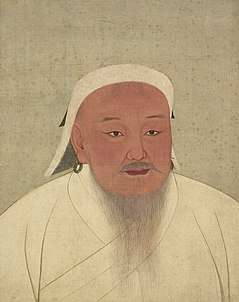
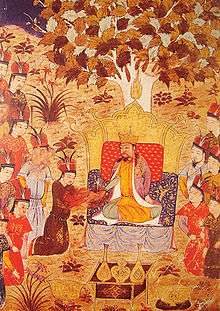
 Tolui with his wife Sorghaghtani Beki
Tolui with his wife Sorghaghtani Beki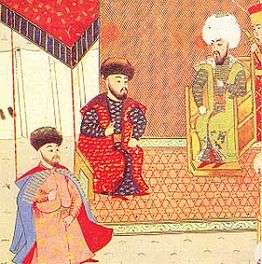 Mengli Giray at the court of Bayezid II
Mengli Giray at the court of Bayezid II
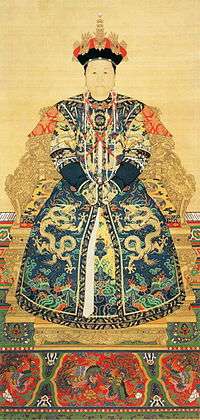
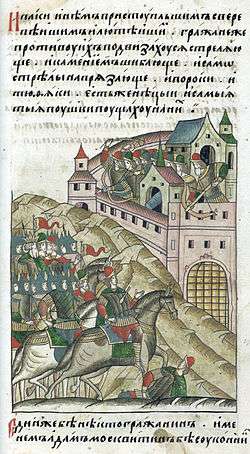
See also
| Wikimedia Commons has media related to Borjigin. |
- Mongol Empire
- Family tree of Genghis Khan
- List of Mongol Khans
- Tatar
- Mongolian name
- List of medieval Mongolian tribes and clans
- History of Mongolia
- Khalkha
- Turco-Mongol
- Timurid dynasty
- List of family trees
Notes
- A Middle Mongolian plural-suffix -t has been written about by Éva Csáki in Middle Mongolian Loan Words in Volga Kipchak Languages.
- Wada Sei did pioneer work on this field, and Honda Minobu and Okada Hidehiro modified it, using newly discovered Persian (Timurid) records and Mongol chronicles.
- According to H. H. Howorth, Mamai used the clan name Kiyad which is near to Genghisid lineage. However, he was not direct descendant of Genghis Khan.[25]
References
Citations
- Encyclopedia Britannica, Incorporated, William Benton Publisher, 1973, p. 726
- mn:Боржигин
- Histoire des campagnes de Gengis Khan, p. 119.
- Li, p. 97.
- Histoire des campagnes de Gengis Khan, p. 118.
- Histoire des campagnes de Gengis Khan, pp. 118, 123.
- Histoire des campagnes de Gengis Khan, pp. 122–123.
- Humphrey & Sneath, p. 27.
- The Secret History of the Mongols, chapter 1, §§ 17, 21.
- Franke, Twitchett & Fairbank, p. 330.
- Kahn, p. 10.
- .
- Atwood, p. 45.
- Perdue, p. 487.
- Crossley, p. 213.
- Halperin, chapter VIII.
- Heirman & Bumbacher, p. 395.
- Sneath, p. 21.
- Humphrey & Sneath, p. 28.
- Weatherford, p. xv.
- "In Search of Sacred Names".
- Magnier.
- Pegg, p. 22.
- "The Genetic Legacy of the Mongols", pp. 717-721.
- The History of the Mongols, part. II, D. II, p. 190.
Sources
- Atwood, C. P. Encyclopedia of Mongolia and the Mongol Empire.
- Crossley, Pamela Kyle. A Translucent Mirror.
- Franke, Herbert; Twitchett, Denis; Fairbank, John King. The Cambridge History of China: Alien Regimes and Border States, 907-1368.
- "The Genetic Legacy of the Mongols". American Journal of Human Genetics, 72.
- Halperin, Charles J. (1985). Russia and the Golden Horde: The Mongol Impact on Medieval Russian History. Indiana University Press. ISBN 0-253-20445-3. ISBN 978-0-253-20445-5.
- Heirman, Ann; Bumbacher, Stephan Peter. The Spread of Buddhism.
- Histoire des campagnes de Gengis Khan (in French). E. J. Brill.
- Humphrey, Caroline; Sneath, David. The End of Nomadism?.
- "In Search of Sacred Names", Mongolia Today, archived from the original on 2007-06-07.
- Kahn, Paul. The Secret History of the Mongols.
- Li, Gertraude Roth. Manchu: A Textbook for Reading Documents.
- Magnier, Mark (October 23, 2004). "Identity Issues in Mongolia". Los Angeles Times.
- Pegg, Carole. Mongolian Music, Dance & Oral Narrative.
- Perdue, Peter C. China Marches West.
- Sneath, David. Changing Inner Mongolia: Pastoral Mongolian Society and the Chinese State.
- Weatherford, Jack. Genghis Khan and the Making of the Modern World. Three Rivers Press.
Further reading
- Wada Sei 和田清. Tōashi Kenkyū (Mōko Hen) 東亜史研究 (蒙古編). Tokyo, 1959.
- Honda Minobu 本田實信. On the genealogy of the early Northern Yüan, Ural-Altaische Jahrbücher, XXX-314, 1958.
- Okada Hidehiro 岡田英弘. Dayan Hagan no nendai ダヤン・ハガンの年代. Tōyō Gakuhō, Vol. 48, No. 3 pp. 1–26 and No. 4 pp. 40–61, 1965.
- Okada Hidehiro 岡田英弘. Dayan Hagan no sensei ダヤン・ハガンの先世. Shigaku Zasshi. Vol. 75, No. 5, pp. 1–38, 1966.
— Royal house — House of Borjigin | ||
| Preceded by Liao dynasty (Yelü) |
Ruling House of Mongolia 11th century–1691 |
Succeeded by Qing dynasty (Aisin Gioro) |
| New title | Ruling House of the Mongol Empire 1206–1368 |
Succeeded by Northern Yuan dynasty |
| Preceded by Jin dynasty Song dynasty |
Ruling House of China 1271–1368 |
Succeeded by Ming dynasty |
| New title | Protector of Tibet 1270–1354 |
Succeeded by Phagmodrupa Dynasty |
| Preceded by Khwārazm-Shāh dynasty |
Ruling House of Persian Empire 1247–1335 |
Succeeded by Jalayirids Chupanid Suldus |
| Preceded by The Khanate established |
Ruling House of the Golden Horde 1236–1502 |
Succeeded by Kiyat Girays Tatars |